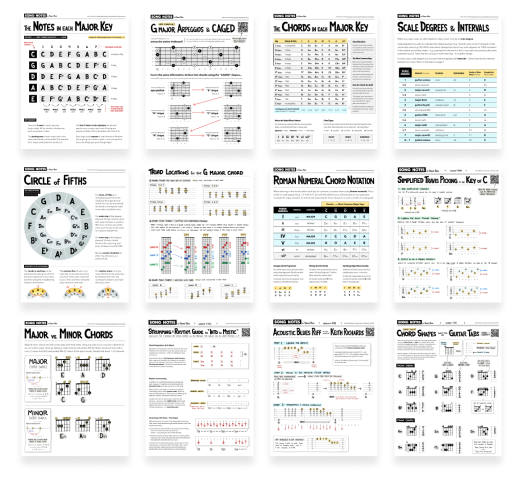Add easy flourish to C-F-G-Am
Lesson #223 • Mar 4, 2019
Video Overview
Instructional PDF 2 pages
Editor’s notes
A favorite tip of mine, while playing songs in the key of C, is using the following improvisational flourish to spice up the C, Am, F, and G chords. By only removing & adding a single finger on your left hand – middle, index, or pinky – you can create a distinct effect on each of the four chords mentioned above. What’s better, is you can mix and match these flourish notes freely - and it’ll always sound good! In this lesson, I’ll show you how.
For each of the techniques below, get comfortable by being able to remove & add the individual left-hand finger noted in each heading – for each of the four chords. Once you feel comfortable with this, try to play freely using these four chords - in any order you want, using any strumming pattern you want! Add & remove the noted finger as you desire. Then learn the next technique – and return to the improvisational play, this time switching up which fingers you’re removing or adding.
The end result is ideally the ability to freely jump between these four chords, but do so in a way where you’re always able to add interesting flourish via the techniques shown here.
Technique 1: Removing/Adding Middle Finger
E ––0––––0–– ––0––––0–– ––0––––0–– ––3––––3––
B ––1––––1–– ––1––––1–– ––1––––1–– ––0––––0––
G ––0––––0–– ––2––––0–– ––2––––0–– ––0––––0––
D ––2––––0–– ––2––––0–– ––3––––3–– ––0––––0––
A ––3––––3–– ––0––––0–– –––––––––– ––2––––0––
E –––––––––– –––––––––– –––––––––– ––3––––3––
C * Am * Fmaj7 * G *
Technique 2: Removing/Adding Index Finger
E ––0––––0–– ––0––––0–– ––3––––3–– ––3––––3––
B ––1––––0–– ––1––––0–– ––1––––0–– ––0––––1––
G ––0––––0–– ––2––––2–– ––2––––2–– ––0––––0––
D ––2––––2–– ––2––––2–– ––3––––3–– ––0––––0––
A ––3––––3–– ––0––––0–– –––––––––– ––x––––x––
E –––––––––– –––––––––– –––––––––– ––3––––3––
C * Am * Fadd9 * G *
Technique 3: Removing/Adding Pinky Finger
E ––0––––3–– ––0––––3–– ––0––––3–– ––3––
B ––1––––1–– ––1––––1–– ––1––––1–– ––0––
G ––0––––0–– ––2––––2–– ––2––––2–– ––0––
D ––2––––2–– ––2––––2–– ––3––––3–– ––0––
A ––3––––3–– ––0––––0–– –––––––––– ––2––
E –––––––––– –––––––––– –––––––––– ––3––
C * Am * Fmaj7 Fadd9 G
Chord shapes
Here’s the four chord shapes we’ll be basing this practice tip upon. These chords are very frequently used together in songs (they’re all in the key of C), so it’s very common you’ll use them together.
E ––0–– ––0–– –(1)– ––3––
B ––1–– ––1–– ––1–– ––0––
G ––0–– ––2–– ––2–– ––0––
D ––2–– ––2–– ––3–– ––0––
A ––3–– ––0–– ––3–– ––2––
E ––––– ––––– –(1)– ––3––
C Am F G
Here’s the specific finger positions we’ll want to use for this practice tip. For the F and the G specifically, you’ll want to follow the my notes below (which will enable you to add the flourish I’ll show later on):
E ––0–– E ––0–– E ––x–– E ––3–– <= left pinky
B ––1–– <= left index B ––1–– <= left index B ––1–– <= left index B ––0––
G ––0–– G ––2–– <= left ring G ––2–– <= left middle G ––0––
D ––2–– <= left middle D ––2–– <= left middle D ––3–– <= left ring D ––0––
A ––3–– <= left ring A ––0–– A ––x–– A ––2–– <= left middle
E ––––– E ––––– E ––x–– E ––3–– <= left ring
C Am F G
For the F, there’s actually a few ways you can approach it (all of which are easier than the full 6-string barred version). It’s ideal to know all of these:
E ––x–– E ––x–– E ––0–– E ––3–– <= left pinky
B ––1–– <= left index B ––1–– <= left index B ––1–– <= left index B ––1–– <= left index
G ––2–– <= left middle G ––2–– <= left middle G ––2–– <= left middle G ––2–– <= left middle
D ––3–– <= left ring D ––3–– <= left pinky D ––3–– <= left ring D ––3–– <= left ring
A ––x–– A ––3–– <= left ring A ––x–– A ––x––
E ––x–– E ––x–– E ––x–– E ––x––
F F Fmaj7 Fadd9
Good luck!
I hope this was helpful for you. As always, it’s best to see my video lesson for reference. Please let me know what questions you have, and until next time - best of luck!
Enjoy My Lessons? Show Your Support!
Most of the lessons on my website are 100% free. If you have the means, please show your support with a tip jar contribution. I put many hours into every lesson — but it only takes you a minute to make a donation. You have my thanks!
Looking for More Song Lessons?
Featured Courses
Fun & Helpful Tools I've Made
Coming soon is Jambox – which shows all the video jam tracks I've made. It's note quite ready for the spotlight, but check it out if you like!
Subscribe to my YouTube channel
Be sure to never miss a lesson by subscribing on YouTube. I put out 2-3 new videos every week. These include full song lessons, as well as covers, practice tips, behind-the-scenes updates. Thanks!
Recent Lessons
-
Dec 19, 2025
"Fairytale of New York" by The Pogues
-
Dec 12, 2025
"The Christmas Song" by Nat King Cole
-
Dec 4, 2025
"If I Needed You" by Emmylou Harris & Don Williams
-
Nov 21, 2025
Learn to Play "Hey Joe", Step-by-Step
-
Nov 15, 2025
Songs Using the One-Four-Five Chords
-
October 31, 2025
"Long Cool Woman (In a Black Dress)" by The Hollies
-
October 24, 2025
"Dust in the Wind" Intro Fingerstyle, Step-by-Step
-
Oct 18, 2025
"America" by Simon & Garfunkel
-
Oct 8, 2025
Rhythm Deep-Dive: "Wild World" by Cat Stevens


